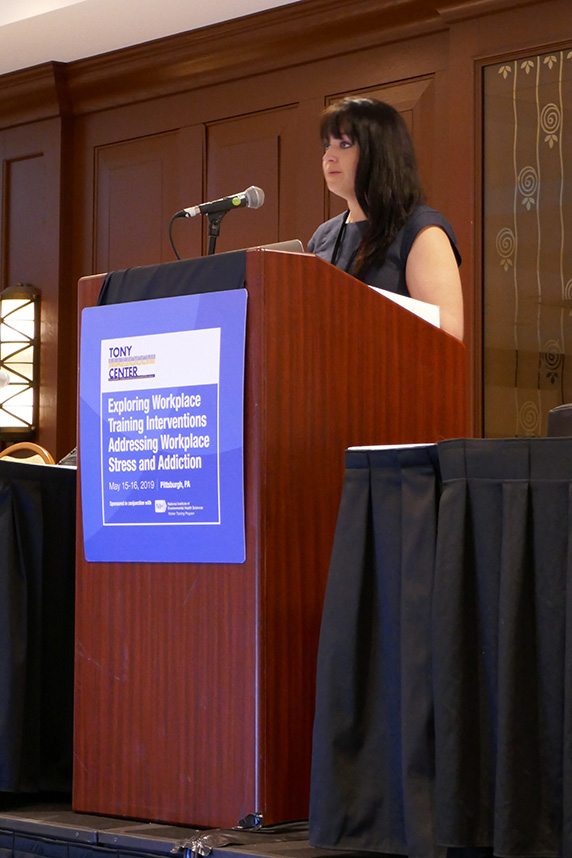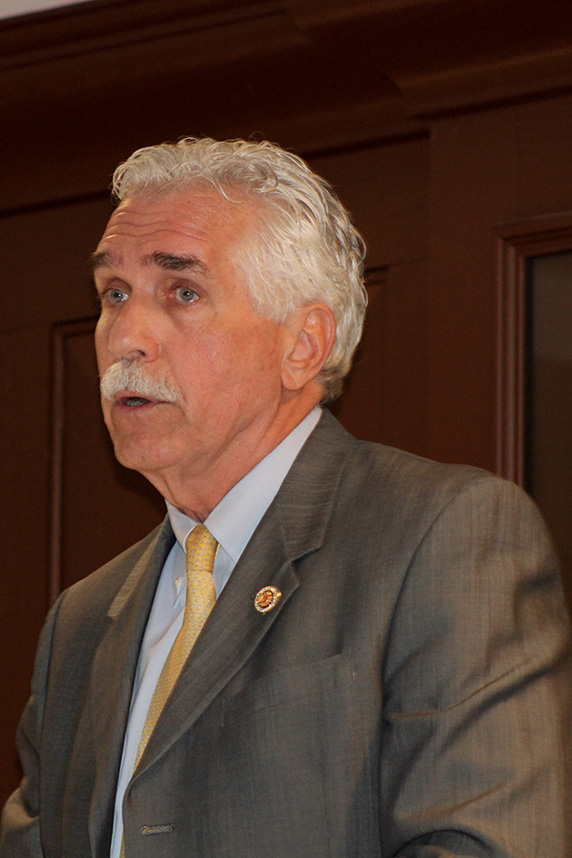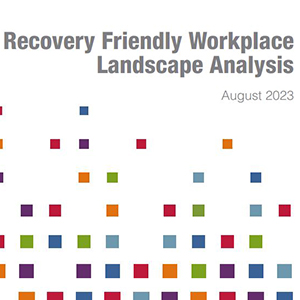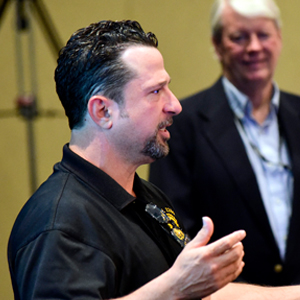Interventions to reduce workplace stress and addiction took center stage at the 2019 Worker Training Program (WTP) workshop May 15-16 in Pittsburgh. WTP seeks to improve the mental health and wellbeing of workers by engaging in conversations like these.
Connections: Work, stress, and addiction
 Fitch explained the theme of the workshop, which was co-sponsored by WTP and the Tony Mazzocchi Center for Health, Safety, and Environmental Education, the primary training entity for WTP grantee SCEO. (Photo courtesy of Demia Wright)
Fitch explained the theme of the workshop, which was co-sponsored by WTP and the Tony Mazzocchi Center for Health, Safety, and Environmental Education, the primary training entity for WTP grantee SCEO. (Photo courtesy of Demia Wright)According to the National Institute for Occupational Safety and Health (NIOSH), lower wages and long hours can contribute to stress in workers. Such stress is common in physically demanding and hazardous jobs, like those in the construction, industrial, transportation, and other sectors targeted by WTP training. Post-traumatic stress disorder also occurs, notably among workers involved in emergency and disaster response.
Recently, WTP grantees have reported that these stressors, as well as opioid addiction and suicide, are affecting the populations they train. “Impacts on mental health can last longer than most physical injuries,” said Ashlee Fitch, lead researcher for the Steelworkers Charitable and Educational Organization (SCEO), a WTP grantee.
WTP Director Joseph “Chip” Hughes agreed, adding that workers often deal with these issues in silence. “Today, we are here to break down the stigma and better understand the role that workplace factors play in stress and addiction,” Hughes said at the workshop.
 Hughes, right, shared his thoughts on ways WTP focus strategies to prevent workplace stress, substance use, and addiction. (Photo courtesy of Demia Wright)
Hughes, right, shared his thoughts on ways WTP focus strategies to prevent workplace stress, substance use, and addiction. (Photo courtesy of Demia Wright)Prevention and intervention
Prevention and intervention strategies are needed to address workplace stress and addiction, according to Cora Roelofs, Sc.D., an occupational health research scientist at the University of Massachusetts, Lowell. She said WTP’s expertise and national reach offers many opportunities to embed these strategies in worker empowerment, education, and training.
Roelofs also said that prevention at the source is most ideal, with efforts aimed at lessening the primary risk factors and stressors that lead to addiction, such as job-related injuries.
Peer support is an effective intervention model, helping ensure workers have a meaningful pathway for recovering from addiction and returning to work safely.
 “Mental and behavioral health are big issues for the fire service,” Morrison said during the keynote address. “As a peer, one fire fighter helps another and provides a trusted bridge to services that are needed.” (Photo courtesy of Cleveland Smith)
“Mental and behavioral health are big issues for the fire service,” Morrison said during the keynote address. “As a peer, one fire fighter helps another and provides a trusted bridge to services that are needed.” (Photo courtesy of Cleveland Smith)Patrick Morrison, assistant general president for health, safety, and medicine for WTP grantee the International Association of Fire Fighters (IAFF), explained the importance of peer support for fire fighters during the keynote address. He said that peer support and behavioral health services have been successful at the IAFF Center of Excellence in Behavioral Health Treatment and Recovery, which has treated more than 750 fire fighters since it was formed in 2017.
Hughes said that IAFF’s work provides a great example of tailoring treatment to suit the individual worker, because one size does not fit all.
Sharing stories, eliminating stigma
There is stigma associated with mental health and addiction due to workers’ fear of losing their jobs, appearing helpless, and other reasons. Participants agreed that sharing stories is an effective method to not only eliminate stigma, but also to raise awareness and empower workers to seek help.
Workshop speakers such as Stephanie Campbell, director of the New York State Ombudsman Project, and Allan McDougall, coordinator for the United Steelworkers Emergency Response Team, shared their impactful, personal stories of recovery.
 “I want to raise the bar of education and intervention, and to prevent others from going down the same road that I did,” said McDougall as he shared his personal story of recovery. (Photo courtesy of Demia Wright)
“I want to raise the bar of education and intervention, and to prevent others from going down the same road that I did,” said McDougall as he shared his personal story of recovery. (Photo courtesy of Demia Wright)Steve Romero, health and safety expert and union representative for the International Union of United Automobile, Aerospace, and Agricultural Implement Workers of America, shared a story about the tragic loss of his brother Jeff, who died a year earlier after prolonged narcotics use. “I know there is nothing I can do to bring back my brother, but by sharing his story, I can do something to help others,” Romero said.
Changing the narrative
Stakeholders must be educated on the connection between addiction and job-related injuries, trauma, and other workplace hazards. Workshop participants agreed that to accomplish this, the narrative surrounding these issues in media, health care, and the workplace must change.
“As a program, we can change the narrative,” said Fitch. “We know what the headlines say now, but what should they say in the future?”
Participants gathered in small groups to create headlines that they would like to see in the future, such as the following.
- “Opioid epidemic eliminated.”
- “Re-engineering the workplace: Holistic approaches to make the workplace safer.”
- “New programs radically reduce substance use and addiction: Recovery possible.”
(Kenda Freeman is a research and communication specialist for MDB, Inc., a contractor for the NIEHS Division of Extramural Research and Training.)







